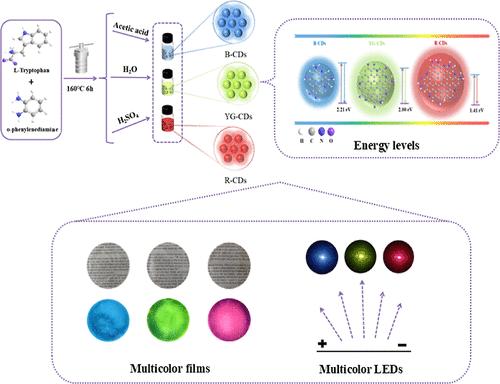Solvent-Engineered Strategy Synthesis of Multicolor Fluorescent Carbon Dots for Advanced Solid-State Lighting Applications
IF 6.5
1区 物理与天体物理
Q1 MATERIALS SCIENCE, MULTIDISCIPLINARY
引用次数: 0
Abstract
At present, achieving tunable fluorescent carbon dots (CDs) with narrow full width at half-maximum (FWHM) and high fluorescence quantum yields (QYs) remains a significant challenge. In our study, l-tryptophan and o-phenylenediamine were utilized as precursors, systematically controlling their band gaps and surface states by varying the solvent type. The blue (B-CDs), yellow-green (YG-CDs), and red (R-CDs) fluorescent CDs were successfully prepared, with optimal excitation wavelengths (λex) of 444, 537, and 597 nm, respectively. Especially, these multicolor CDs (M-CDs) exhibited impressive QYs of 53.69, 54.88, and 58.79%, and narrow FWHM of 71, 64, and 34 nm, respectively. Their distinct optical properties were achieved by manipulating the carbonization and dehydration processes through a solvent selection. The variations in optical properties were primarily attributed to increased amino nitrogen content, quantum size, and coordinated effects of surface oxidation states. Furthermore, M-CDs were successfully incorporated into polyvinyl alcohol (PVA) to produce transparent and flexible fluorescent films, demonstrating their excellent and stable optical quality. Finally, the potential of M-CDs in optoelectronic applications was showcased by fabricating bright light-emitting diodes (LEDs).

溶剂工程策略合成用于先进固态照明应用的多色荧光碳点
目前,实现具有窄半最大全宽(FWHM)和高荧光量子产率(QYs)的可调谐荧光碳点(CD)仍然是一项重大挑战。在我们的研究中,利用 l-色氨酸和邻苯二胺作为前驱体,通过改变溶剂类型来系统控制它们的带隙和表面状态。成功制备出了蓝色(B-CDs)、黄绿色(YG-CDs)和红色(R-CDs)荧光光盘,其最佳激发波长(λex)分别为 444、537 和 597 nm。特别是,这些多色光盘(M-CDs)分别表现出令人印象深刻的 53.69%、54.88% 和 58.79% 的 QYs,以及 71、64 和 34 nm 的窄 FWHM。它们独特的光学特性是通过选择溶剂操纵碳化和脱水过程实现的。光学性质的变化主要归因于氨基氮含量的增加、量子尺寸以及表面氧化态的协调效应。此外,还成功地将 M-CD 与聚乙烯醇(PVA)结合,制备出透明柔韧的荧光薄膜,证明了其卓越稳定的光学品质。最后,通过制造明亮的发光二极管(LED),展示了 M-CD 在光电应用方面的潜力。
本文章由计算机程序翻译,如有差异,请以英文原文为准。
求助全文
约1分钟内获得全文
求助全文
来源期刊

ACS Photonics
NANOSCIENCE & NANOTECHNOLOGY-MATERIALS SCIENCE, MULTIDISCIPLINARY
CiteScore
11.90
自引率
5.70%
发文量
438
审稿时长
2.3 months
期刊介绍:
Published as soon as accepted and summarized in monthly issues, ACS Photonics will publish Research Articles, Letters, Perspectives, and Reviews, to encompass the full scope of published research in this field.
 求助内容:
求助内容: 应助结果提醒方式:
应助结果提醒方式:


